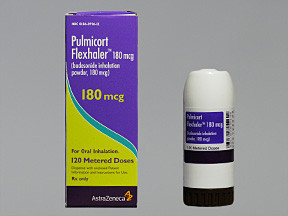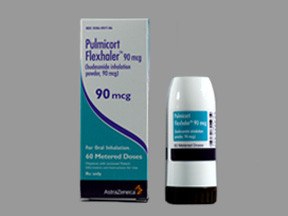BUDESONIDE BREATH-ACTIVATED INHALER - ORAL
PHONETIC PRONUNCIATION: (bue-DES-oh-nide)
COMMON BRAND NAME(S): Pulmicort
GENERIC NAME(S): budesonide
Uses
USES: Budesonide is used to control and prevent symptoms (wheezing and shortness of breath) caused by asthma. This medication belongs to a class of drugs known as corticosteroids. It works directly in the lungs to make breathing easier by reducing the irritation and swelling of the airways. This medication must be used regularly to be effective. It does not work right away and should not be used to relieve sudden asthma attacks. If an asthma attack occurs, use your quick-relief inhaler as prescribed.
How to use BUDESONIDE BREATH-ACTIVATED INHALER - ORAL
HOW TO USE: Read the Patient Information Leaflet provided by your pharmacist before you start using budesonide and each time you get a refill. Read the directions provided by the manufacturer on the correct use of this device (including a dose counter if one is available). If you have any questions, consult your doctor or pharmacist. If you are using the US product: follow the instructions for priming the inhaler if you are using it for the first time. There is no need to prime the device again. If you are using the Canadian product: the inhaler does not need to be primed before use. Do not shake this product, and do not use a spacer with it. Hold the device upright while using. If the inhaler device is dropped or shaken, or if you accidentally breathe into the device after the dose has been loaded, you will lose the dose. Load another dose. Do not use the inhaler if it has been damaged or if the mouthpiece has come off. Inhale this medication by mouth, usually once or twice daily or as directed by your doctor. Inhale deeply and forcefully while using the device. Turn your mouth away from the device to breathe out before inhaling. Do not exhale back into the device. If your prescribed dose is 2 puffs, wait at least one minute between them. If you are using other inhalers at the same time, wait at least 1 minute between the use of each medication, and use this drug (the corticosteroid) last. To prevent dry mouth, hoarseness, and oral yeast infections from developing, gargle and rinse your mouth with water after each use. Do not swallow the rinse water. Keep track of each dose of medication you use. Discard the device after it has delivered the labeled number of doses or when the red mark reaches the bottom of the dose indicator window. The dosage is based on your medical condition and response to treatment. Use this medication regularly to get the most benefit from it. To help you remember, use it at the same time(s) each day. Do not increase your dose or use this drug more often or for longer than prescribed. Your condition will not improve any faster, and your risk of side effects will increase. Learn which of your inhalers you should use every day (controller drugs) and which you should use if your breathing suddenly worsens (quick-relief drugs). Ask your doctor ahead of time what you should do if you have new or worsening cough or shortness of breath, wheezing, increased sputum, worsening peak flow meter readings, waking up at night with trouble breathing, if you use your quick-relief inhaler more often (more than 2 days a week), or if your quick-relief inhaler does not seem to be working well. Learn when you can treat sudden breathing problems by yourself and when you must get medical help right away. If you are regularly using a different corticosteroid (such as prednisone), you should not stop using it unless directed by your doctor. You may have withdrawal symptoms if the drug is suddenly stopped. Some conditions (such as asthma, allergies) may become worse when the drug is suddenly stopped. To prevent withdrawal symptoms (such as weakness, weight loss, nausea, muscle pain, headache, tiredness, dizziness), your doctor may direct you to slowly lower the dose of your old medication after you are using budesonide. Consult your doctor or pharmacist for more details, and report any withdrawal reactions right away. See also Precautions section. You may notice a benefit within 24 hours of starting this drug. It may take 1-2 weeks before the full benefit of this drug takes effect. Tell your doctor if your symptoms do not improve or if they worsen. The Canadian inhaler is not the same as the US inhaler. Do not substitute the 2 products without talking with your doctor. Your dose may need to be changed.
Side Effects
Precautions
Interactions
Overdose
Images
Reviews
Faq for BUDESONIDE BREATH-ACTIVATED INHALER - ORAL
Budesonide Breath-Activated Inhaler is used to control and prevent symptoms such as wheezing, shortness of breath, and chest tightness caused by asthma. It is also used to treat inflammation of the nasal passages.
Budesonide is a corticosteroid that works by reducing inflammation in the airways and nasal passages. It acts locally in the lungs and nose to decrease swelling and mucus production, thereby improving breathing.
To use the inhaler, shake it gently, breathe out completely, and place the mouthpiece between your teeth and close your lips around it. Inhale deeply and forcefully while pressing down on the canister to release the medication. Hold your breath for a few seconds, remove the inhaler, and then exhale slowly. Rinse your mouth with water after each use to minimize the risk of throat irritation.
If you miss a dose, skip the missed dose and continue with your regular dosing schedule. Do not double dose to make up for a missed one. It is important to use the inhaler regularly as prescribed by your doctor for maximum benefits.
Common side effects may include headache, throat irritation, hoarseness, cough, or fungal infections in the mouth. These side effects are usually mild and go away on their own. However, if you experience severe or persistent side effects such as difficulty breathing, rapid heartbeat, or allergic reactions, seek medical attention immediately.
Yes, Budesonide Breath-Activated Inhaler can be used by children above 6 years of age under the supervision of an adult. The dosage and administration instructions may vary for children, so it is important to consult a healthcare provider for the appropriate use.
Budesonide may interact with certain medications, including ketoconazole, clarithromycin, ritonavir, and other drugs that can inhibit liver enzymes. Inform your doctor or pharmacist about all the medications you are taking, including prescription, over-the-counter, and herbal products, to avoid any potential interactions.
Answer: Budesonide breath-activated inhaler - oral is used to prevent asthma attacks and symptoms of chronic obstructive pulmonary disease (COPD) in adults and children.
Answer: Budesonide is a corticosteroid that works by reducing inflammation in the airways, thereby preventing or reducing the frequency and severity of asthma attacks or COPD symptoms.
Answer: Common side effects may include headache, sore throat, cough, dry mouth, or hoarseness. These side effects are usually mild and go away on their own.
Answer: The frequency of use will vary depending on the individual and the severity of their condition. It is usually recommended to use this inhaler once or twice a day, as directed by your doctor.
Answer: No, this medication is not intended for immediate relief of acute asthma symptoms. It is meant for long-term prevention and management of asthma or COPD symptoms. You should have a rescue inhaler for immediate relief during an asthma attack.
Answer: No, you should not stop using this medication suddenly without consulting your doctor. It is important to follow your doctor's instructions on how to gradually reduce the dose to avoid withdrawal symptoms.
Answer: Yes, this medication is approved for use in children over the age of 6 years for the treatment of asthma and children over the age of 12 years for the treatment of COPD. The dosage and frequency may vary based on the child's age and condition.
Answer: It is important to inform your doctor or pharmacist about all the medications you are currently taking, including over-the-counter drugs and herbal supplements. Some medications may interact with Budesonide and affect its effectiveness or increase the risk of side effects.
Answer: It is important to carefully read and follow the instructions provided with the inhaler. Generally, you should shake the inhaler well, exhale fully, place the mouthpiece in your mouth, and inhale forcefully while pressing down on the canister. Hold your breath for a few seconds before exhaling slowly.
Disclaimer
IMPORTANT: HOW TO USE THIS INFORMATION: This is a summary and does NOT have all possible information about this product. This information does not assure that this product is safe, effective, or appropriate for you. This information is not individual medical advice and does not substitute for the advice of your health care professional. Always ask your health care professional for complete information about this product and your specific health needs.


No Reviews Yet